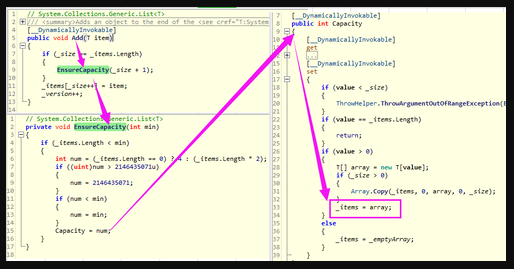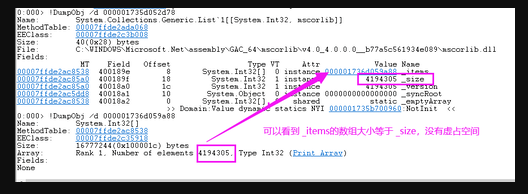一文看懂C#中List的扩容机制
一线码农上海 人气:0一:背景
1. 讲故事
在前一篇大内存排查中,我们看到了Dictionary正在做扩容操作,当时这个字典的count=251w,你把字典玩的66飞起,其实都是底层为你负重前行,比如其中的扩容机制,当你遇到几百万甚至千万的大集合这个扩容机制还真的需要挖一下,免的入戏太深,难以自拔。

二:List扩容机制
1. 如何查看
要想看它的扩容机制,可以用ILSpy去看看List的源码即可,非常简单。

从源码的 int num = (_items.Length == 0) ? 4 : (_items.Length * 2) 可以非常清楚的看到,4个空间起步,后面都是 *2 的扩容,也就说当你有 2^(n-1) + 1 个元素,实际上你需要占用 2^n个空间。
下面我用C#代码演示一下:
static void Main(string[] args)
{
var list1 = Enumerable.Range(0, (int)Math.Pow(2, 22)).ToList();
var list2 = new List<int>(list1);
list2.Add(1);
Console.WriteLine($"list1.Capacity={list1.Capacity}");
Console.WriteLine($"list2.Capacity={list2.Capacity}");
Console.ReadLine();
}
------ output -------
list1.Capacity=4194304
list2.Capacity=8388608
从代码中可以看到,当List中已有 4194304个元素的时候,再往其中塞入一个元素,仅仅是多一个,在底层可是翻倍的空间占用哦,太可气了,要想往深处看可以用windbg看一下各自数组占用大小。
0:000> !DumpObj https://img.qb5200.com/download-x/d 000001ec037d2e20
Name: System.Collections.Generic.List`1[[System.Int32, mscorlib]]
Fields:
MT Field Offset Type VT Attr Value Name
00007ffde2ac8538 400189e 8 System.Int32[] 0 instance 000001ec147b9c10 _items
00007ffde2ac85a0 400189f 18 System.Int32 1 instance 4194304 _size
00007ffde2ac85a0 40018a0 1c System.Int32 1 instance 4194304 _version
00007ffde2ac5dd8 40018a1 10 System.Object 0 instance 0000000000000000 _syncRoot
00007ffde2ac8538 40018a2 0 System.Int32[] 0 shared static _emptyArray
>> Domain:Value dynamic statics NYI 000001ec01bc0920:NotInit <<
0:000> !do 000001ec147b9c10
Name: System.Int32[]
MethodTable: 00007ffde2ac8538
EEClass: 00007ffde2c35918
Size: 16777240(0x1000018) bytes
Array: Rank 1, Number of elements 4194304, Type Int32 (Print Array)
Fields:
None
0:000> !do 000001ec037d2e78
Name: System.Collections.Generic.List`1[[System.Int32, mscorlib]]
MethodTable: 00007ffde2ada068
EEClass: 00007ffde2c3b008
Size: 40(0x28) bytes
File: C:\WINDOWS\Microsoft.Net\assembly\GAC_64\mscorlib\v4.0_4.0.0.0__b77a5c561934e089\mscorlib.dll
Fields:
MT Field Offset Type VT Attr Value Name
00007ffde2ac8538 400189e 8 System.Int32[] 0 instance 000001ec167b9c80 _items
00007ffde2ac85a0 400189f 18 System.Int32 1 instance 4194305 _size
00007ffde2ac85a0 40018a0 1c System.Int32 1 instance 1 _version
00007ffde2ac5dd8 40018a1 10 System.Object 0 instance 0000000000000000 _syncRoot
00007ffde2ac8538 40018a2 0 System.Int32[] 0 shared static _emptyArray
>> Domain:Value dynamic statics NYI 000001ec01bc0920:NotInit <<
0:000> !do 000001ec167b9c80
Name: System.Int32[]
MethodTable: 00007ffde2ac8538
EEClass: 00007ffde2c35918
Size: 33554456(0x2000018) bytes
Array: Rank 1, Number of elements 8388608, Type Int32 (Print Array)
Fields:
None
可以清楚的看到,一个int[] 占用 16777240 byte /1024/1024 =16M,一个 int[] 占用 33554456 byte/1024/1024 =32M,可这是翻倍的空间哈。
2. 真的以为是仅仅翻了一倍吗?
为什么我要这么说呢?仔细看看Capacity的Set实现,如下代码:
public int Capacity
{
get{ return _items.Length; }
set
{
if (value > 0)
{
T[] array = new T[value];
if (_size > 0)
{
Array.Copy(_items, 0, array, 0, _size);
}
_items = array;
}
}
}
大家仔细研读,这个流程是先定义好新size的数组array,然后将老的数组(_items) copy到 新数组array中,然后将array的引用给了老的数组,不难看出真正的Size应该是 array(32M) + _items(16M) =48M 才是真正的大小,只要GC没有回收老的_items(16M)那就一直保持48M的大小,你说呢?
要怎么验证呢? 大家可以用windbg去看看托管堆中 int[] 不就可以啦。
var list1 = Enumerable.Range(0, (int)Math.Pow(2, 22)).ToList(); list1.Add(1); 0:000> !DumpHeap -mt 00007ffde2ac8538 -min 102400 Address MT Size 0000024c103e9ba0 00007ffde2ac8538 4194328 0000024c107e9bd8 00007ffde2ac8538 8388632 0000024c10fe9c10 00007ffde2ac8538 16777240 0000024c11fe9c48 00007ffde2ac8538 33554456 Statistics: MT Count TotalSize Class Name 00007ffde2ac8538 4 62914656 System.Int32[] Total 4 objects
从信息中看(16777240 + 33554456)byte = 48M,按照刚才的理论这个16777240的int[]应该是没有引用根的等待被GC回收,所以用!gcroot 把两个 int[] 都打印出来。
0:000> !gcroot 0000024c10fe9c10 Found 0 unique roots (run '!GCRoot -all' to see all roots). 0:000> !gcroot 0000024c11fe9c48 Thread 63dc: 0000007b4abfee60 00007ffd85950938 ConsoleApp6.Program.Main(System.String[]) [C:\dream\Csharp\ConsoleApp1\ConsoleApp6\Program.cs @ 28] rbp-38: 0000007b4abfee88 -> 0000024c00002da0 System.Collections.Generic.List`1[[System.Int32, mscorlib]] -> 0000024c11fe9c48 System.Int32[] Found 1 unique roots (run '!GCRoot -all' to see all roots).
可以看到:0000024c10fe9c10 确实是没有引用根,也就验证了其实真正的是48M,而不是32M,翻了2倍哦。。。有点小恐怖。
二: 如何压缩
1. 系统提供的压缩机制
回过头来看 Capacity 属性中的扩容机制,你只需要将Capacity设置与Count平齐,_items数组多余的虚占空间就给清掉了。
static void Main(string[] args)
{
var list1 = Enumerable.Range(0, (int)Math.Pow(2, 22)).ToList();
list1.Add(1);
list1.Capacity = list1.Count;
Console.ReadLine();
}

从图中可以看到,数组中的 8388608-4194305 =4194303 个int直接给灭掉了,优化了空间。
2. 自定义List
其实问题的根源出在了扩容机制,举个例子,如果当length大于400w的时候,默认情况下是翻倍成800w,有时候根据你的业务不需要翻到800w,其实500w就足够了,这样300w的虚占就可以免掉,所以必要的时候自己实现一个list,然后灵活控制它的扩容机制,妙哉妙哉~~~
五:总结
明白扩容机制对你了解在大数据量下使用List还是非常有帮助的,大家根据自己的场景合理化使用,下一篇我们聊一聊HashSet。
加载全部内容